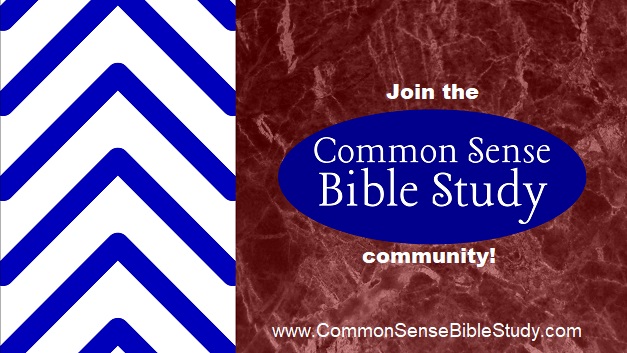In the last lesson of Common Sense Bible Study I talked about reading the Bible for what it is, considering context and purpose before assuming the meaning of any particular passage. In previous installments we looked at Bible translations and several ways that a student of the Bible might get lost in the theological weeds.
In this lesson, I’m going to talk about Bible study tools, starting with the most essential.
Now, I know what you’re thinking. Encyclopedias, commentaries, dictionaries… Super exciting stuff! #Sarcasm
But you have no idea how exciting a good concordance can be!
Nah, not really. You’d have to be pretty desperate for entertainment to find a Bible concordance exciting.
Seriously, though, Bible study tools might not sound very exciting, but they are important. Reading the Bible by itself with much prayer and meditation will take you a very long way toward an understanding of God’s wisdom and his will for mankind, but a person would have to be a very determined fool to ignore the accumulated knowledge of thousands of years of intelligent and dedicated people who spent their lives studying the Scriptures. They haven’t always been right, but they have often been insightful and even brilliant.
There are many kinds of study tools, so I’m only going to talk about those you are most likely to encounter and that are most likely to be useful to you.
Ready? Go!
The Essential Tools
The Bible
Of course, a good, formal translation of the Bible is the most essential tool. Unless you can read the original Hebrew and Greek, you can’t study the Bible without one. (And if you can read the original Hebrew and Greek, you’re probably not taking this course.) Not just one translation. I recommend having a few so that you can compare to get a good grasp of plausible alternative meanings.
Here are some good choices:
- English Standard Version (ESV)
- New American Standard Bible (NASB)
- New King James Version (NKJV)
- Revised Standard Version (RSV)
Although the King James Version is quite literal, I didn’t include it because it’s very difficult to understand for most readers today.
I also recommend having a few dynamic translations and special-purpose Bibles for the added perspective. Just don’t take them too literally. (Hah! That’s a pun.)
Here are some good choices of non-literal Bibles:
- Brenton English Septuagint (Brenton). I included Brenton with the non-literal translations because it’s an English translation of a Greek translation of the Old Testament, introducing another layer of potential errors.
- Complete Jewish Bible (CJB). The Old Testament is more literal than the New Testament. The CJB is an attempt to restore Jewish thought patterns and names to the Scriptures, and so necessarily incorporates an amount of speculation.
- New International Version (NIV) Not Today’s NIV nor the NIV, Inclusive Language Edition, both of which have been compromised with political and ideological agendas.
- The Voice
This isn’t an all-inclusive list. There are other good Bible translations. See the previous lesson on Bible Translations.
The cheap way to build a collection of Bibles is to use an app that you install on your phone or computer (like e-Sword) or one of a number websites (like https://www.biblegateway.com/). Electronic Bibles have the added and important benefit of being searchable, which is a literal God-send when you remember reading something, but just can’t quite remember where it was.
On the other hand, many people like to highlight and make notes in their Bible. You can do this with some Bible apps too, but clicking and dragging and typing notes into a database isn’t really the same thing. If you appreciate a more tactile approach to your Bible study, you’ll need a paper Bible or two. If you’re going to fill the pages with color and ink, you’re going to run out of space eventually, so you should consider something on the cheaper side so you can periodically start over with a clean copy without breaking the bank.
Concordance
A Bible concordance is your electronic Bible’s search function, but in a book. Basically, it’s a list of every word found in a particular English translation of the Bible, with each word indexed to all of the verses where it can be found.
That’s helpful, but in the digital age, I don’t consider an index of English words to be all that special. What elevates a concordance to an essential Bible study tool, is its cross-referencing of the English words to the Hebrew or Greek equivalents, and the reverse index that lists every verse where a particular Hebrew or Greek word can be found.
That last is most important, and electronic tools shine here again. Most Bible apps come with a concordance, and the best of them will include an English Bible (usually KJV) that tags every English word with its Strong’s Concordance index number. Here’s a screenshot from e-Sword.
Notice the little purple numbers next to each word in the upper pane? Those are called Strong’s Numbers for short. They are index numbers for Greek words (If they were Hebrew, they would start with an H instead of a G) from Strong’s Concordance of the King James Bible. When I click on the G1135 next to “women” in Acts 1:14, e-Sword brings up the Greek word (γυνή), a transliteration using Latin characters (gunē), and an index of verses that contain that Greek word.
Looking at how a word is used throughout Scripture can really open up a world of meaning. For example, take a look at this article I did on the meaning of various Hebrew and Greek words that can be translated into English as “love”: God’s Loving Graciousness.
There are two drawbacks to e-Sword’s KJV concordance:
- It’s not really complete. I’ve noticed that it doesn’t always list every instance that a word appears in the text. I don’t know if that’s because the word was missing from the original source or if something went wrong when they imported the index into the software.
- It’s KJV-only. Some more recent translations use different source texts than that used by the KJV, and while the variations don’t affect any major Christian doctrines, it would be nice to have more than the one index.
There are other concordances available with other study apps and websites. For example, Biblehub.com uses the New American Standard Exhaustive Concordance.
Hebrew & Greek Dictionaries
Knowing how the original word is used in the Bible can tell you a lot about what it means, but many words don’t appear more than a handful of times, and some words appear only once. Dictionary creators also consult contemporary usage in extra-Biblical sources to get a better understanding of how words were used by the original readers of the Biblical texts. Good Hebrew & Greek dictionaries can tell you what a word meant in Biblical times without having to look up every time it’s used in Scripture.
E-Sword comes with a couple of free dictionaries in both languages:
Hebrew
- Strong’s Hebrew Dictionary
- Brown-Driver-Briggs’ Hebrew Definitions
Greek
- Strong’s Greek Dictionary
- Thayer’s Greek Definitions
Most other free apps will use these same dictionaries. They’re a very good starting place and are sufficient for most Bible students, but they were all compiled more than a century ago, which is why they’re free. Modern linguists have access to much older and many thousands more ancient manuscripts, so really serious scholars will want to invest in more up to date dictionaries.
There are a number of other study tools that I’ll cover in the next installments (see below), but I consider having several good Bible translations, a concordance, and Hebrew/Greek dictionaries to be the bare essentials of Bible study.
Coming up:
- Bible Commentaries
- Dictionaries (not the same as Hebrew & Greek dictionaries)
- Encyclopedias
- Bible/Gospel Harmonies
- Histories
- Study Bibles
- Lectionaries
- Devotionals
- Atlases
I’ll be a little more brief in discussing these tools. I promise to keep it as pain-free as I can!
Everything that Yeshua (aka Jesus) & the Apostles taught
Come with me as I draw out the connections that are so often missed |

